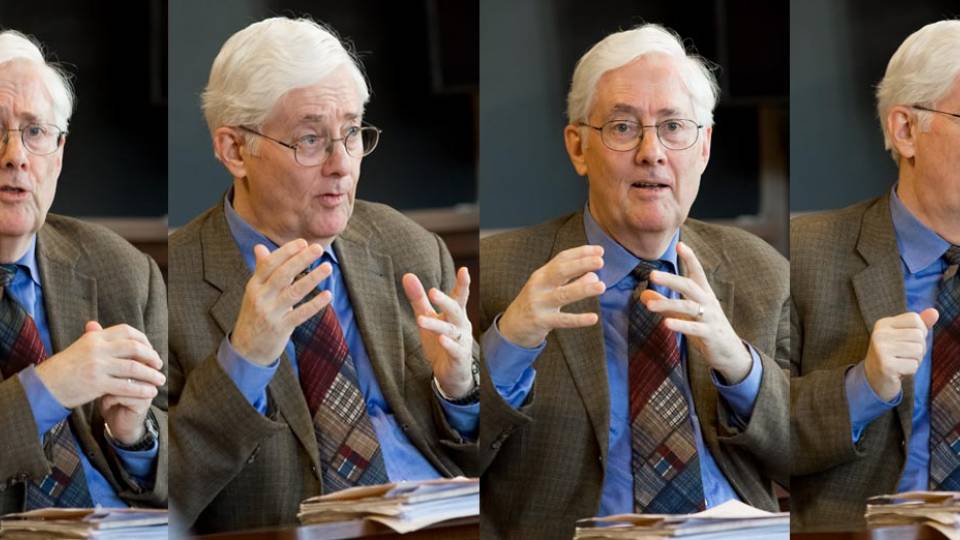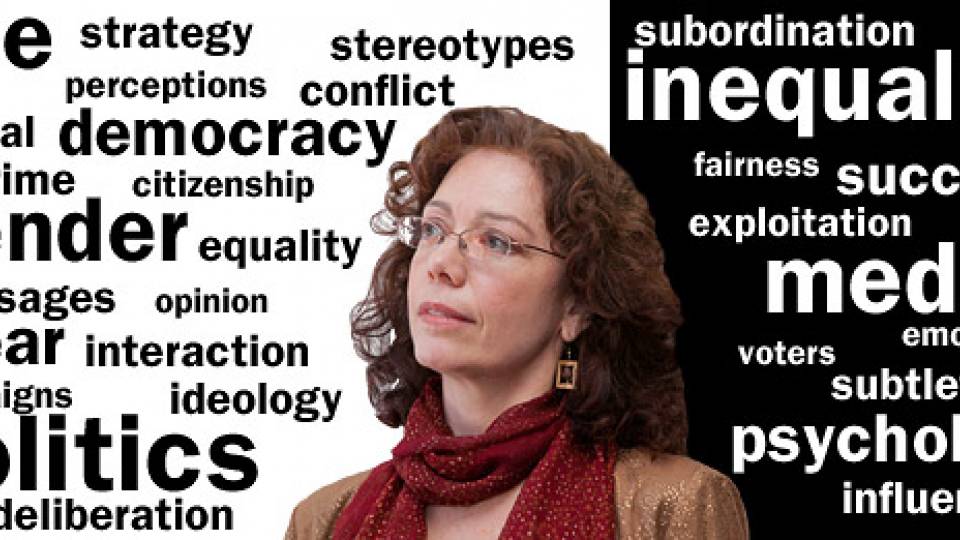From the March 27, 2006, Princeton Weekly Bulletin
The specter of public opinion hangs over all decisions made by the U.S. president, but how much weight does potential popularity carry in the policy-making process? Do presidents or the public drive the policy agenda?
Princeton presidential scholar Brandice Canes-Wrone examines these and other key questions about the relationship between presidents and the public in her book “Who Leads Whom? Presidents, Policy and the Public,” published in 2005 by the University of Chicago Press. Canes-Wrone explores the shifting role of public opinion during various stages of presidential terms and how much influence the president can exert on the American people in promoting his initiatives. The book analyzes presidential policy-making from Dwight Eisenhower’s second term through Bill Clinton’s second term, reflecting the rise of television as the primary medium through which the president communicates directly with the public.
Canes-Wrone, a 1993 graduate of Princeton, joined the University faculty as an associate professor of politics and public affairs in fall 2004. She previously served on the faculty at Northwestern University and the Massachusetts Institute of Technology. Her fields of specialty include presidential, legislative and bureaucratic politics, as well as the study of elections. She recently discussed the issues raised in her new book.
What have you discovered through this book about the relationship between public opinion and presidential policy-making? You note the concern among today’s scholars and some Founding Fathers that catering to public opinion too strongly could result in demagoguery. Does your research find that concern to be well founded?
My evidence suggests that those concerns tend to be overblown, that presidents are not as apt to follow public opinion as the founders might have predicted. Presidents actually have incentives under a number of conditions not to follow mass opinion, though they also have an incentive not to publicize too heavily that they’re doing so. Under many circumstances, presidents want to pass the policy that they think will produce good results — whether or not it’s popular.
How big a role do citizens’ preferences play in presidents’ policy decisions?
Citizens’ preferences play a role in three ways. The first is that presidents are concerned about the ways in which citizens ultimately will view policies. In addition, they can use a mass appeal to go over the heads of Congress to try to leverage public opinion. I think the perception among presidents and much of the public is that if the president is popular he can go on TV and shift public opinion to get what he wants. All of my evidence suggests that the time at which a president can use public appeals most effectively is when he has a policy the public wants and Congress — for whatever reason, be it party balance, interest group pressure — doesn’t want to enact that policy. That’s what we saw with Reagan when he went on TV for his tax cuts. That’s what we saw with Clinton and the budget debates with the 104th Congress in 1995 and 1996 — that’s when he was really effective, not when he was pushing unpopular policies at the beginning of his first term.
Finally, there are certain circumstances under which it does make sense to pander to public opinion — that tends to be when the next election is fairly soon and when the president anticipates a close race. By pandering, I mean promoting a policy because it’s popular — even when presidents have information that suggests the policy may not ultimately be in voters’ interest.
However, it is worth underscoring that one of the major arguments of the book is that presidents have fewer incentives to pander to public opinion than the conventional wisdom suggests. The book shows that presidents’ levels of popularity do not affect whether they will pander to public opinion.
Of the group you studied, which presidents were most likely to pander to public opinion?
I find that the individual differences among presidents are minor relative to the structural conditions. So things we tend to think of as very personality-based tend to be diminished significantly by more structural effects, such as the electoral environment.
For example, we saw Jimmy Carter, who had been promoting an expansion of humanitarian aid, proposing to cut humanitarian aid during the electoral race in 1980. Another example is the first President Bush, who was against extending unemployment benefits during the recession of the early ’90s, but once the electoral race heated up he found reasons to support extending unemployment benefits.
In the book, I go through other reasons that these presidents could have shifted their opinions: Have the policies changed? Have conditions in the country changed? In the case of the Carter example, have international conditions changed a lot? And I try to rule these out. I also gathered a large data set of policies over time and looked at whether presidents are more likely to take popular positions under the conditions in which I predict pandering would occur. The patterns suggest presidents are indeed more likely to follow public opinion under these predicted conditions.
Other than electoral concerns, what other conditions make presidents likely to pander?
One interesting finding, although it is limited in scope by the small amount of data, regards the behavior of second-term presidents who are facing big scandal investigations or impeachment threats. The presidents who looked most idiosyncratic were Nixon, Clinton and Reagan early in their second terms, when each of them tended to behave like a president who was running for re-election. You don’t usually think of Nixon, for example, as someone who was really likely to pander to public opinion, but the data suggest the Watergate hearings made him more likely to do so.
You cite Clinton’s public appeal in pursuing military action in Bosnia as an example of when presidents can successfully sway public opinion. When have presidents typically been most effective in influencing the American public?
One of the arguments I try to bring home is that presidents are rarely able to change mass opinion in a big way. Presidents always want to think that they can do this. You see this with the current president as well — he went out there with Social Security reform and thought he could shape public opinion. But the evidence, over time, is that voters are not that likely to change their opinions on policies simply because the president is promoting them, even when presidents are very popular. That’s a lesson that presidents find hard to learn.
But there is one big exception, and that’s in foreign policy. That’s where the Clinton-Bosnia example comes in. In foreign policy, presidents are often the primary or only information source available to people. In the long term, other information can seep out about whether a particular involvement is something that voters would want. But in the short term, if the president is telling you that we really need to send troops into Bosnia because it could spill over into Europe, people are unlikely to have hard-and-set views that oppose him. In that sense, it’s not like school prayer or Social Security accounts or health care. Voters are going to say, “I don’t know that much about what’s going on in Bosnia, and this is the president.” There aren’t going to be as many interest groups engaged as there are in domestic issues, and they’re not going to be providing counter-messages. So presidents can do more of what they want, in part because they’re going to be able to lead public opinion more in this area.
You noted that President Bush, like his predecessors, tends to believe he can sway popular opinion. Most recently, he supported the deal for a Dubai company to take control of several U.S. ports, even though polls showed it was very unpopular. What effect do you think public opinion — and his diminished popularity — might have on Bush’s policy-making decisions through the rest of his second term?
As I mentioned earlier, the book argues that highly unpopular presidents are unlikely to pander to public opinion. Thus I would have predicted Bush’s behavior on the Dubai port deal. In fact, I’ve received some nice e-mail from faculty who assigned the book this term, stating that it was great to have a book that squared so well with what we observe the president doing in Washington today.
Furthermore, for Bush in his second term — and second-term presidents more generally — the incentives to pander are not great for any level of popularity unless the president becomes focused on helping a particular member of his administration win the subsequent presidential election.
I also would say that Bush has behaved in other ways that are consistent with how presidency scholars believe second-term presidents behave, in that he seems to have a concern for how he will be evaluated historically. For instance, in his most recent State of the Union address, we saw him making these big statements about decreasing dependence on oil and the fact that we really do need to shift the way we think about energy. Of course, these statements do have specific proposals behind them from the administration. But I think such statements are about more to Bush than just a specific proposal — this is about Bush and his place in the history books in terms of the ways in which he’s trying to direct the country.




